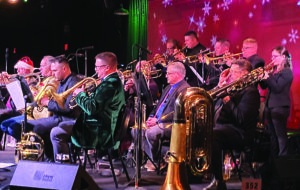By Alex Russell

Colloquially referred to as the “Fellows Property,” this roughly two-acre parcel of land was once the bucolic site of the Fellows family house. But it’s more than just one family’s home — it’s a crucial part of Falls Church’s history, as well as a sizable part of its future plans.
Originally constructed in 1917, the house was “an excellent example of a bungalow dwelling” of the time, according to a report done by the Virginia Department of Historic Resources (VDHR).
Four years after it was built, a Mr. and Mrs. Harold C. Fellows purchased it and, up until recently, the Fellows family had called the property at 604 South Oak St. their home.
Its last resident and owner, Lydia “Betty” Fellows, lived there for most of her life. Due to worsening health, however, Fellows had to leave the property behind. She died in late 2017, at the age of 89. Her family’s connection to the house and to the land itself cannot be understated; it is as much a part of the site’s history as it is of the City of Falls Church.
Melvin L. Steadman’s 1964 book, “Falls Church: By Fence and Fireside,” detailing the early history of the Little City, includes a summary of the Fellows lineage, dating back to the middle of the 19th century.
Among the names listed in the book is Harry Andrew Fellows, born in 1866, and a former mayor of the City of Falls Church. Besides his eight-year tenure as mayor, he also served as president of the Falls Church Citizens Association. During the 43 years he spent in East Falls Church, Fellows had become a staple of his community.
In a way, his descendant Lydia had carried on her family’s strong connection to the City’s on-going history. The Fellows property had been listed on the City’s Open Space Acquisition plan since 2005, with those plans moving forward following Fellows’ passing.
Two years ago, in early 2019, the City purchased the land and embarked on a process of developing and carrying out a Master Park Plan — an undertaking that is expected to be a long and involved affair. The City’s Capital Improvements Program currently has funding ready for the current Fiscal Year, which is aimed at site plan work, as well as for the following Fiscal Year, which is for construction purposes.
According to a Virginia Department of Historic Resources (VDHR) report on the Fellows Property, dated 1996, the Fellows house (that has since been demolished in tandem with the City’s redevelopment work) was situated in a way that capitalized on the natural visage and bounties of the area — a facet of Falls Church that some fear may continue to shrink as further land developments take place throughout the City.
Bradley Gernand, author and Chair of the Mary Riley Styles Public Library Board of Trustees (retired), helped to explain the appeal and benefits of the site’s original state.
The house itself was set up at a good distance from the center of town, with tall shade trees accenting its immediate surroundings. The natural beauty of the location as well as the presence of wildlife was just one of the highlights, though. The property lent itself to a more utilitarian focus as well.
“The soil there is rich, so if they grew crops, they doubtless grew well,” Gernand explained. Prior to a blight that decimated the chestnut tree population in Falls Church, “the chestnut forest” would have provided the Fellows family with “an abundance of excellent firewood,” as well as chestnuts themselves.

As reported in the Environmental Sustainability Council (ESC) of Falls Church proposal for the Fellows property, in the spring of last year, 379 people participated in a Falls Church Recreation and Parks survey that sought to determine how to best utilize the property.
Three options were offered and each person answering the survey could pick as many choices as they wanted.
Option 1: passive recreation, like walking and wildlife observation, was chosen by 304 people; option 2: active recreation — consisting of organized sports as well as playground activities — was selected by 109 people; option 3: preservation of the property’s natural resources, which had the support of 183 respondents.
In terms of preferred amenities, the top seven selections were: benches and picnic tables; trails; a natural play area; a community garden; an open space/large open free play area; a picnic shelter or a gazebo; and a perimeter pathway.
Many survey participants, using the survey’s additional comments section, asked for the planned amenities on the Fellows property to “accommodate all abilities and/or be left as natural as possible.”
Tom Clinton, Commissioner of Revenue for the City, explained that the City Council tends to start “land banking” early on. The City has experienced “infrastructure and capacity problems” at various times, so the long-standing plan to acquire the Fellows property was, in effect, a way for the Council to hedge its bets in terms of its land-use and infrastructure work.
One suggestion presented in the ESC proposal is a new kind of community garden, one that would consist of a single space that would be “maintained via workdays and volunteer sign-ups and operating under a single set of rules regarding gardening practices and techniques.”
This idea would “support the city by creating…demonstration areas and by leading workshops, lessons and workdays,” with community outreach topics including but not being limited to “environmentally suitable garden/land practices, stormwater management, soil conservation…and native habitat maintenance.”
The proposal, besides helping to preserve the area’s wildlife, would also synthesize different programs and needs — like a local effort to “increase food security” by growing edible plants. A number of “potential stakeholders” already operate within the City, like the Falls Church Garden Club, the Friends of Fellows Forest and the Village Preservation and Improvement Society.
In addition, there would be a chance to implement a hands-on approach to teaching visitors about environmental sustainability, thereby nurturing and supporting a more civic-minded and resourceful co-existence with the surrounding wildlife in the Little City.













